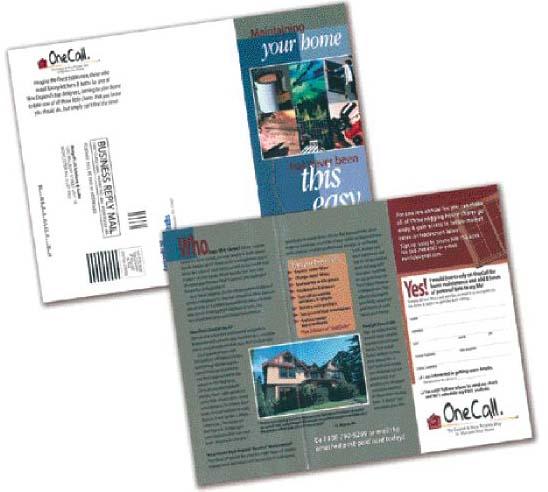Business Articles - Specialty and Trade
Articles & Tips
Although most handyman businesses are one-pickup operations with low overhead and no employees, that's not the only possible business model. I own a full-service kitchen-and-bath remodeling business in eastern Massachusetts that specializes in high-end custom work. For several years now, I've run a handyman service as a sideline, and it's proven to be a worthwhile addition to my main business.
One key benefit is that it lets us turn potential down time into revenue. Although plenty of work is still available, the pace has slowed from what it was a year or two ago when jobs were going begging. In a slower market, the handyman service provides a way to keep my staff busy and paying for themselves while I'm selling that next big job.But even more important, our handyman operation is a valuable marketing tool. It's a way to show new customers that we do prompt, reliable work. Planing doors and patching holes in drywall isn't very profitable, but that's not really the point. Our willingness to do such small jobs and do them well makes us stand out from the competition. When a former handyman customer decides to launch a major remodeling project, we're usually the top choice for that job.
Levels of Service
The idea for a handyman service came out of a request from a remodeling customer we'd done quite a bit of expensive work for over the years. He called in a panic to ask us if we'd come over and put up some Christmas lights before his kids arrived for the holidays.
Naturally, we tried to tell him there was no way we could do something like that. We explained that it would involve pulling carpenters off another job at our usual labor rate of $65 an hour. He said that was fine with him. So, because he was a good customer, I sent a couple of guys to his house. They bought lights at the local hardware store -- charging our regular hourly rate for the necessary time -- then got out a couple of ladders, drove some hooks, and strung up the lights.
It seemed silly at the time, but once we collected the money and stopped laughing, I realized that it might not be such a joke, after all. That simple job had made an existing customer so happy that I began wondering whether thisapproach could also be a self-supporting way to create new customers. I decided to give it a try, and, after a couple of false starts, we developed a three-level approach that seems to work for the types of homeowners we look to for new business.
Annual maintenance. We began by offering an annual home maintenance contract for a flat fee of $695 per year. This includes an initial survey of the house and two scheduled four-hour visits per year by one of our tradespeople. During the first three hours of each visit, we take care of a laundry list of routine jobs that, as builders, we know most customers simply never do, including caulking baths and showers, changing hvac filters, sealing grout, and even testing fire extinguishers and replacing smoke-alarm batteries. The final hour of each visit is reserved for any odd jobs that the customer might want to have done, from replacing faucet washers to installing towel bars.
We advertised this service on our website and with a trifold brochure that we handed out to prospects and mailed to past remodeling customers (see Figure 1).

Figure 1. The brochure for the author's home maintenance program details the handyman services the company can provide and contains a postage-paid mail-in card. The company's full-service remodeling business is mentioned only in passing, but more complete information is later provided to all contacts and new customers.
One Call projects. In the beginning, we thought the yearly maintenance program would be our biggest seller. But after some discussions with customers, we realized that it wasn't what most of them really wanted. They weren't balking at the $65 hourly rate, but instead of having us replace filters and batteries, they wanted us to take care of a wide variety of odd jobs around the house. In effect, it was the last hour of the maintenance plan that interested them, not the first three.
We spun off a second program we named One Call: Customers tell us what kinds of small jobs they need done, and one of our workers takes care of them at the usual hourly rate. This is our most popular service.
Service sales projects are jobs that are too large to estimate over the phone. In those cases, we schedule an initial visit to look over the job and prepare an estimate. Instead of charging an hourly rate for these sales service jobs, we quote a price as we would for a remodeling project.
To prevent unnecessary paperwork, though, we don't use our standard remodeling contract, which assumes that there will be pages of drawings and specifications -- things that have little bearing on most $2,000 repair jobs. Instead, we have customers sign a simple one-page proposal on our letterhead, which has space for the scope of work, price, and terms of payment; it also contains a basic disclaimer (Figure 2). For most small jobs, the terms are payment upon completion, although we sometimes get a deposit for larger small jobs.
 |
Figure 2. For basic
repair or service projects that exceed the scope of the company's by-the-hour
handyman service, the author uses a simple one-page contract printed on company
letterhead. Figure 3. Potential
customers who contact the company by e-mail are asked to fill out a simple registration
form. In addition to proving useful for planning site visits, that information
can be used to identify future remodeling prospects.
This article has been provided by www.jlconline.com. JLC-Online is produced by the editors and publishers of The Journal of Light Construction, a monthly magazine serving residential and light-commercial builders, remodelers, designers, and other trade professionals. Connect with customers looking to do your most profitable projects in the areas you like to work.
Tracking and Assigning Jobs
For this system to work, the person who takes the initial calls has to have
enough experience to identify the level of service required. At some point we
may try to develop a detailed lead sheet that allows a support person to do
this, but so far I've been handling the initial calls myself.
Registration. Since one of the main reasons
for having a handyman service is to develop a file of customers who might someday
be interested in having major work done, we complete a simple registration form
for all new customers during the initial phone call. Customers can also fill
out the form themselves at our website and send it in by e-mail (Figure 3).
There's also a space on the form for prospects to describe the types of maintenance
and repair jobs they'd like us to do.

This makes it clear at the outset that we're interested in establishing a long-term
relationship, not just rustling up a few hours' worth of odd jobs. Once we have
the pertinent information, like age of home, type of heat, number of baths,
and so forth, we call and set up an appointment for the first project.
One Call or service sales? Yearly maintenance
work is straightforward and easily defined, so the real challenge is differentiating
the relatively simple One Call projects from service sales work. In general,
we try to keep One Call jobs under $1,000; if it's going to be more than that,
we prefer to bump it into the sales service category and do an estimate.
Say a customer calls and asks us to replace some wallplates. It's easy to come
up with a time estimate for that, but relying on the customer for information
is not always so simple. A call about a sticking door could mean the customer
needs a few minutes' work with a power plane, or it could mean a failed foundation.
So even though we do our best to get it right at the outset, sometimes what
we find at the house isn't what we expected. If the worker I've sent to handle
the job finds that it's a bigger project than we thought, he calls me on his
cell phone right away. Then I get on the line with the customer and tell them
I'm sorry, but it looks like the job is more complicated than we thought. If
the customer wants to go ahead, we bump it up into the service sales category
and treat the initial call as an estimating visit.
This sometimes leads to some pretty large jobs. In a recent case, a couple told
us they were having problems keeping paint on their fascia trim. This turned
out to be a whole complex of problems: Gutters weren't working, #3 pine trim
wasn't backprimed and had started to rot, and an absence of drip-edge at the
eaves was allowing roof runoff to get between siding and wall. It turned out
to be a $50,000 job.
Those customers weren't happy about spending that much money, but they were
happy to find someone who could actually fix the problem. By the time people
get around to calling us, they've often tried unsuccessfully to fix a given
problem several times, either by working on it themselves, getting a family
member to work on it, or having the small local handyman give it a try. When
we get there, they're ready to pay what it costs to have the job done right.
The fact that we're a bigger company with an established reputation for doing
quality work gives us the credibility that customers are looking for.
To the rescue. This is also true of "rescue
jobs," when we're called in to finish or repair projects started by someone
else. A year and a half ago, I turned in a $200,000 bid for an addition, which
ended up going to a contractor who turned in a much lower bid. After $40,000
in change orders, the customers were within a few thousand of what they would
have spent to have us do it, and they were stuck with a five-page punch list
of items they'd given up trying to get the original contractor to come back
and do. We finished everything off in a couple of days. There's no way the first
guy is going to get any more work from those people, but I'm sure we will.
Labor Requirements
As remodelers who do a lot of work in occupied houses, we've had a lot of practice
keeping customers happy. Everyone who works for us is well trained in being
timely, polite, and presentable and doing neat, high-quality work. Although
a lot of the small jobs require little in the way of carpentry skills, we send
our own carpenters out on about 60% of our handyman jobs.
In other cases, we'll send an electrician or a painter or some other sub. We
can do this with confidence because we've trained our subs to work to the same
standards as our employees. Handyman work is no different than large-scale remodeling
work in this respect: The customers don't necessarily know or care who's directly
employed by the contractor and who's a sub; they just want the job to be done
well by a neat and courteous worker.
Contract labor. All remodelers struggle with
allocating employees, but small handyman jobs make this even trickier. The maintenance
part of our business is easy to schedule because it's steady and predictable.
That's not true of the One Call and service projects. They make unpredictable
labor demands that require us to juggle employees between jobs to get everything
done.
One thing that has really helped us is our relationship with two local labor
services that provide us with both long-term and short-term tradespeople. We
pay the labor service an hourly rate for the workers we need, and the service
takes care of worker's comp, payroll taxes, and associated paperwork. I estimate
that these contract employees cost about a dollar an hour more than my own employees,
but relying on them when we need to lets us increase or decrease the size of
our work force without making new hires or laying off any permanent employees.
During busy times, we've had as many as 15 labor-service people working for
us at once.
Although it might sound risky to allow temporary employees to represent your
company, that hasn't been a problem for us. Most of our "temps" are actually
indistinguishable from our regular employees. They wear the same uniforms as
our regular employees, get the same training and the same year-end bonus, and
they do the same high-quality work. One of our best lead carpenters is a contract
worker who has been with us for about four years.
Appliance Installation
We continue to look for new ways to expand our handyman division. We recently
began partnering with a local retailer to install ranges, cooktops, refrigerators,
and other appliances. Finding this work doesn't require any effort on our part
-- the appliance store just gives customers our card and tells them to contact
us about installation.
This can work one of two ways. If the customer calls us after they've made the
purchase, we get the necessary information over the phone, provide a labor estimate,
and schedule the job as we would a standard One Call project.
In other cases, homeowners will call us before committing themselves to a particular
appliance because they want to be sure they buy something that fits the available
space. For a flat $50 fee, we'll send someone out to take measurements and let
them know what their rough opening requirements are. Once the customer makes
a choice based on the information we've provided, they often have us come back
to do the actual installation at our normal hourly rate. In that case, we'll
give them a credit for the initial $50 fee.
Low profile, high returns. When doing appliance
work, we don't say much about our kitchen-and-bath business unless the customer
specifically asks. We don't want to leave the impression that we're using our
relationship with the appliance store to pressure them into buying something
from us. But after the job is done, we make a point of sending the customers
a follow-up letter thanking them for their business, along with a copy of the
newsletter that describes our additional services (Figure 4).

Figure 4. All handyman
customers receive a thank-you letter and a copy of the company newsletter, which
contains information on products, design trends, and details on the company's
design-build services.
That approach has been very successful. A few months ago, we sent a mailing
to a customer after we'd installed an oven for her. She was already happy with
the quality of our work, so she had no hesitation about hiring us to build her
an elaborate new mahogany deck.
Certified kitchen designer Peter Lawton
is owner and president of designPLUS, a design-build remodeling company in Worcester,
Mass.
Join our Network

